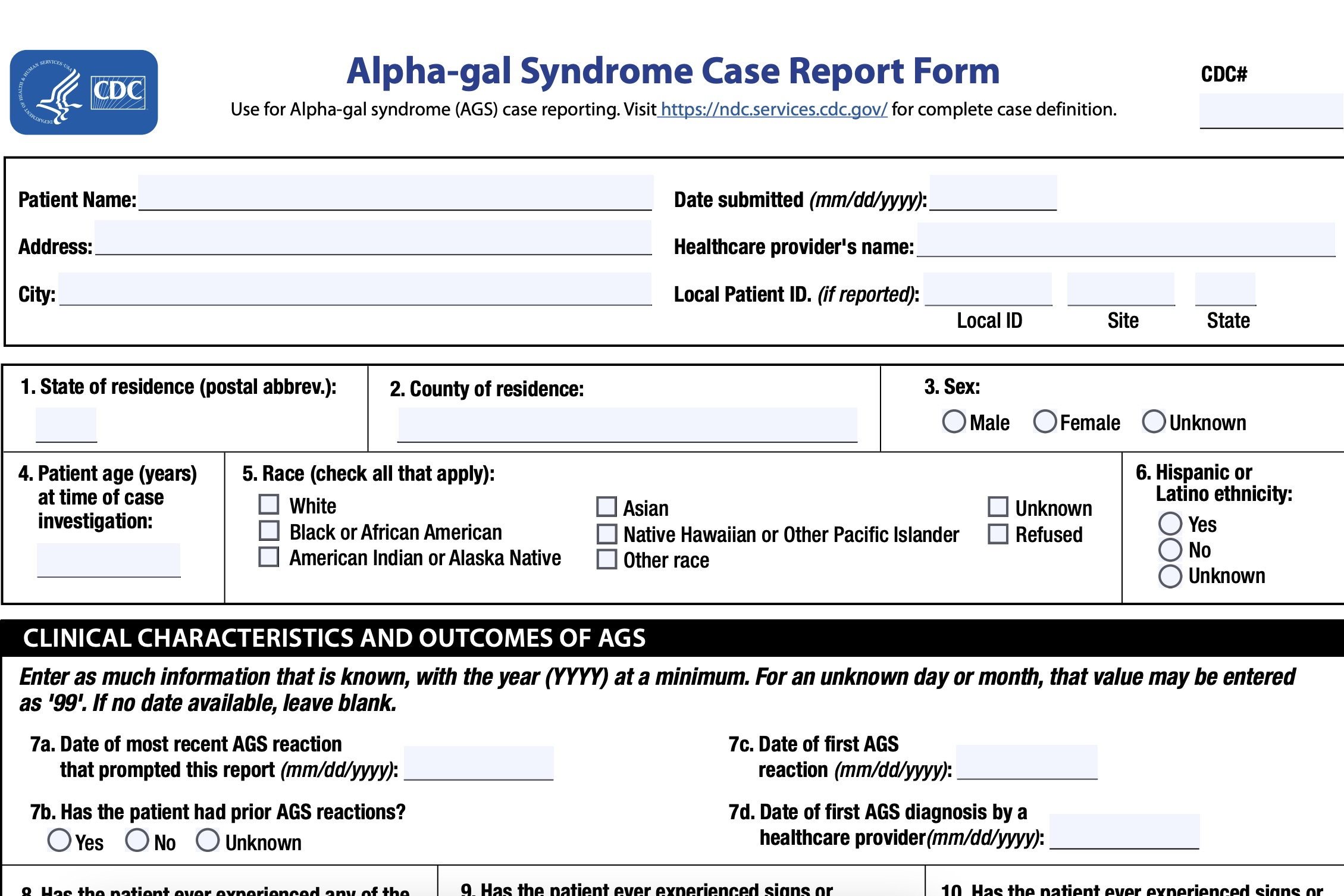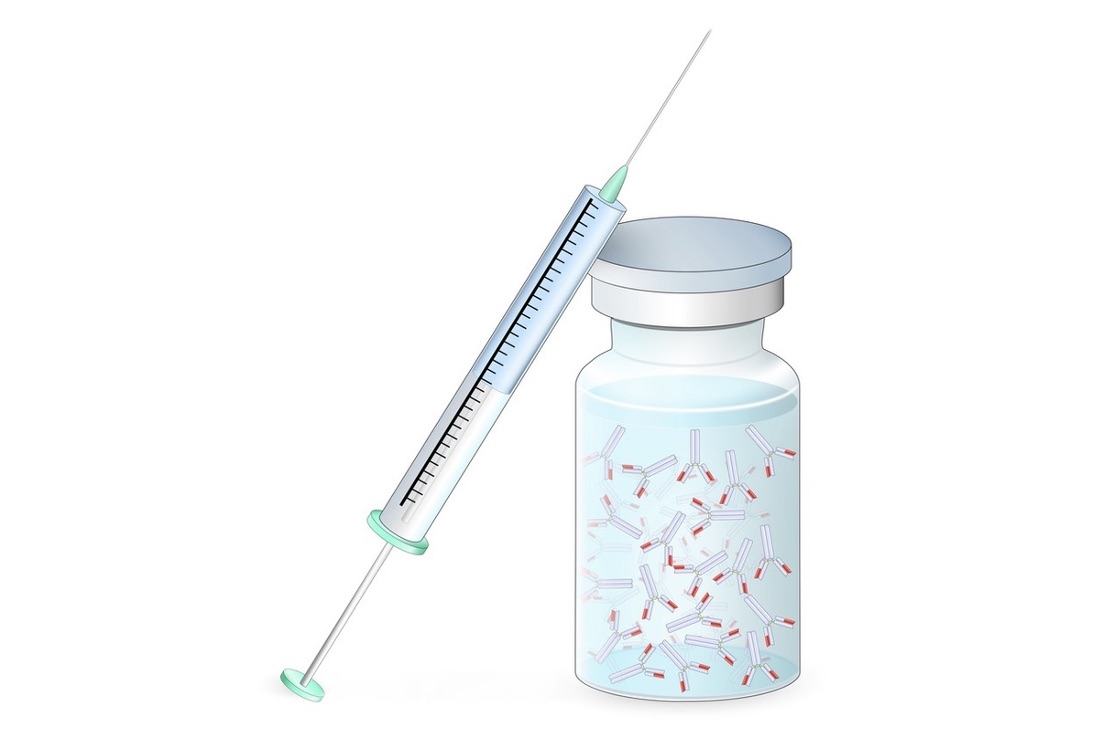Area of focus #4
Research & epidemiology
Additional areas of focus
Drugs and medical devices
Food
Education
Prevention
Goal
Advance alpha-gal syndrome (AGS) research and surveillance
Priority #1
Improve surveillance of alpha-gal syndrome to aid public health decision-making

Challenge
- Public health experts, including the CDC, the Congressionally-mandated Tick-Borne Disease Working Group, and alpha-gal syndrome experts8,13,57,58 have identified a critical need for improved surveillance of AGS in order to:
- Determine the true incidence and prevalence of AGS in the general population
- Aid public health decision-making
- Identify hotspots and high-risk populations for targeted public health outreach and healthcare provider education
- Monitor the growth and expansion of AGS
- Quantify the overall burden of tick-borne disease in areas where AGS makes up the bulk of this burden
- Facilitate epidemiologic and laboratory research
- Evaluate the effectiveness of control and prevention programs
- Provide timely alerts to healthcare providers as to important changes in trends
- In order for effective surveillance to be initiated, existing surveillance infrastructure needs to be updated and expanded.
- In addition, there is a need to explore differences in disease burden across population groups to identify geographic, social, biological, and other determinants of risk.
Opportunities
- Work with the CDC, CSTE, and federal, state, and local governments to make AGS a mandatory reportable tick-borne condition.
- Secure federal funding for states and localities to expand AGS surveillance capacity, including funding to modernize data collection.
- Secure federal funding for additional surveillance work, including a patient registry and studies of the prevalence of a-Gal IgE sensitization in the general population.
Alignment with National public health strategies and expert recommendation
- In his 2020 paper “Diagnosis & management of alpha-gal syndrome: lessons from 2,500 patients,” expert Scott Commins, MD, PhD called for the CDC to make AGS reportable.13
- In their 2023 report “Geographic Distribution of Suspected Alpha-gal Syndrome Cases — United States, January 2017–December 2022” the CDC identified a critical need for:
- Improved surveillance to aid public health decision-making 8
- The CDC also created a surveillance case definition of AGS and is encouraging states and local jurisdictions to share information on AGS with members of CDC’s Rickettsial Zoonoses Branch to better understand national trends.130
- The 2024 National Public Health Strategy to Prevent and Control Vector-Borne Diseases (VBD) in People, which includes AGS as a vector-borne condition, has identified a need to:
- Better understand when, where, and how people are exposed to and get and die from vector-borne diseases 59
- Modernize data collection systems59
- Expand capacity for the surveillance of vector-borne conditions 59
- Provide support, including sufficient staff and technical assistance, to states, tribes, and partners to implement effective VBD programs, including surveillance 59
- Identify differences in the clinical presentation, disease processes, progression, and clinical outcomes of VBDs associated with specific demographic factors, co-morbidities, and social determinants of health, particularly as they relate to differences across communities 59
- Evaluate alternative data sources and tools, including patient registries, to further inform surveillance and integrate usable alternative data into relevant systems 59
- In their 2020 report “On the cause and consequences of IgE to galactose-a-1,3-galactose: A report from the National Institute of Allergy and Infectious Diseases Workshop on Understanding IgE-Mediated Mammalian Meat Allergy,” an international group of experts convened the NIH identified a need to:
- Determine the prevalence of a-Gal IgE sensitization in the general population and its association with (1) mammalian meat allergy, (2) other allergic reactions (e.g. vaccine reactions), and (3) other medical conditions (e.g. atherosclerotic disease)57
- Determine the prevalence of a-Gal IgE sensitization in the general population and its association with (1) mammalian meat allergy, (2) other allergic reactions (e.g. vaccine reactions), and (3) other medical conditions (e.g. atherosclerotic disease)57
If testing trends continue, and the geographic range of the lone star tick continues to expand, the number of AGS cases in the United States is predicted to increase during the coming years, presenting a critical need for synergistic public health activities including… improved surveillance to aid public health decision-making.
The prevalence of AGS cases is unknown, and it remains a challenge for widespread integration of AGS into healthcare training and awareness.
Considerations to increase awareness of AGS could include making the diagnosis reportable, which could be accomplished in conjunction with the Centers for Disease Control and Prevention.
Priority #2
Deepen our understanding of the immunological mechanisms and natural history of alpha-gal syndrome

Challenge
- Alpha-gal syndrome was only described in 2009 and is poorly understood.13,22
- AGS is a paradigm-shifting syndrome that has already radically revised our understanding of the cause and consequences of allergy.13,57,132
- As the only allergy for which a definitive cause (tick bites) has been established, AGS offers a unique lens through which to study the cellular and molecular mechanisms that drive allergy.13,57,132
- Many aspects of alpha-gal syndrome are atypical of other allergies. Research on the natural history of AGS is needed both to understand its novel features and to broaden our understanding of allergy in general,57,132 including:
- Mechanisms of its onset
- Its progression
- The full range of its presentation, including GI-only and rheumatological presentations
- Mechanisms that drive its resolution
- The development of mast cell disorders secondary to AGS
- In addition, further research on the implications of alpha-gal sensitization in the absence of clinical allergy is needed, including study of the possible relationship between sensitization and:
- Diseases involving chronic inflammation, e.g. atherosclerosis and rheumatological conditions
- Autoimmune disease
- Post-infectious syndromes
- Understanding alpha-gal syndrome’s cellular and molecular mechanisms and natural history is a prerequisite to developing effective therapies.
Opportunities
- Secure federal funding for basic and clinical research on alpha-gal syndrome’s molecular and cellular mechanisms and natural history.
- Secure federal funding for research on atypical presentations of AGS, including GI and rheumatological phenotypes, AGS complicated by mast cell syndromes, and the relationship between sensitization to alpha-gal and cardiovascular and other non-allergic disease.
- Secure federal funding for additional as-of-yet unfulfilled, basic research priorities outlined by AGS experts in the report from the National Institute of Allergy and Infectious Diseases Workshop on Understanding IgE-Mediated Mammalian Meat Allergy
Alignment with National public health strategies and expert recommendation
- The National Public Health Strategy to Prevent and Control Vector-Borne Diseases (VBD) in People, which includes AGS as a vector-borne condition, has identified a need to:
- Tick-Borne Disease Working Group 2022 Report to Congress: 3rd Report called for:
- Providing HHS with the resources necessary to fund basic research and clinical research to investigate the pathology of the human immune response following tick bites (e.g. alpha-gal syndrome).129
- In their 2024 paper “Tick bites, IgE to galactose-alpha-1,3-galactose and urticarial or anaphylactic reactions to mammalian meat: The alpha-gal syndrome,” leading experts Wilson JM, Erickson L, Levin M, Ailsworth SM, Commins SP, and Platts-Mills TAE called for exploration of the following questions:
- What factors at the tick–host interface drive total and alpha- gal IgE?
- What are the mechanisms that explain the delay and heterogeneity of symptoms?
- Does IgE to alpha-gal contribute to chronic inflamma-
tory diseases (e.g. atherosclerosis)? - Can a diet including mammalian products contribute to
atherosclerosis in individuals with IgE to alpha-gal who
are not aware of allergic symptoms?
- In their 2020 report “On the cause and consequences of IgE to galactose-a-1,3-galactose: A report from the National Institute of Allergy and Infectious Diseases Workshop on Understanding IgE-Mediated Mammalian Meat Allergy,” an international group of experts convened the NIH identified a need to:
Although there are many ways that a-Gal could be considered to ‘‘break the rules,’’ investigation into this unusual allergen is likely to reveal novel insights into the causes and consequences of all allergic diseases.
Understanding the underlying immune mechanisms is fundamental to designing allergen-specific treatments that can be safe and effective in the long term.
Arguably, the most important public health consequence of tick bites, might well be the increased burden of atherosclerosis in alpha-gal sensitised individuals, first described by Wilson et al. and confirmed in a large cohort by Vernon et al.
Of concern, is that given only a minority of those sensitised will clinically express mammalian meat allergy, around 25% of those in tick endemic regions might possess a risk factor for atherosclerosis of which they are unaware.
Priority #3
Develop, improve, and evaluate tools and protocols for the diagnosis of alpha-gal syndrome

Challenge
Need for low-cost, accessible diagnostic tools and protocols
- The National Public Health Strategy to Prevent and Control Vector-Borne Diseases in People calls for advancing equity in the diagnosis and management of vector-borne conditions.
- There are significant equity gaps in the diagnosis of AGS between higher and lower-income countries.
- Diagnosis of AGS is hampered in developing countries due to lack of access to the alpha-gal IgE blood test.55
Other research priorities
- Published data related to the characteristics of alpha-gal IgE testing is lacking, including more basic parameters such as sensitivity, specificity, as well as positive and negative predictive values.8
- Funding is needed for larger population studies which represent an important opportunity to define these diagnostic issues.8
- Since the advent of laboratory-developed tests for alpha-gal IgE, there have been growing anecdotal reports of seronegative cases of AGS, i.e. people who present with classic symptoms of AGS who test negative for alpha-gal IgE.*
- Independent evaluation of the efficacy of newer, lab-developed alpha-gal IgE tests is needed.
*Personal communications
Opportunity
Secure federal funding to:
- Develop and refine low-cost, low-tech, diagnostic alternatives (including tools and protocols) to the alpha-gal IgE blood test
- Develop international, evidence-based guidelines for the diagnosis and management of AGS
- Evaluate the efficacy of existing diagnostic tools and protocols, especially those appropriate for use in underserved populations where the alpha-gal IgE is not available
- Compare the efficacy of new, lab-developed alpha-gal IgE blood tests to that of the pre-existing Viracor test
Alignment with National public health strategies and expert recommendation
- The National Public Health Strategy to Prevent and Control Vector-Borne Diseases in People, which includes AGS as a vector-borne condition, calls for:
- Continuously monitoring emerging science that may inform the diagnosis of VBDs 59
- Updating and disseminating guidance, recommendations, and guidelines for diagnosis of VBDs, to include methods for reducing disparities in diagnosis 59
- The dissemination and implementation of public health tools, programs, and collaborations to detect and diagnose vector-borne conditions 59
- The development and dissemination of guidance, recommendations, and guidelines on effective diagnostic test methods and procedures, including for interpretation of test results (e.g., laboratory and clinical parameters) and methods to reduce disparities in diagnosis 59
- Comparison of the characteristics and performance of new and existing tests to inform test guidance59
- Support of the development of consensus guidelines or expert opinion on diagnosis59
- The 2024 National Public Health Strategy to Prevent and Control Vector-Borne Diseases (VBD) in People, which includes AGS as a vector-borne condition, also identified a need to:
- Use an equity-centered approach to prevent and control VBDs and eliminate health inequities. 59
- Advance equity for communities that are underserved and at disproportionate risk of exposure to vector-borne conditions. 59
- Embed health-equity principles into the design, implementation, and evaluation of research, data, surveillance, intervention, and evaluation strategies for prevention and control of vector-borne conditions.59
- Facilitate partnerships across sectors, including disproportionately affected and underserved communities, to develop tools and reduce health disparities.59
Some authors consider serum IgE specific to alpha-gal to be the most effective diagnostic test, as alpha-Gal-decorated glycoprotein bovine thyroglobulin has shown a diagnostic sensitivity of 100% and a specificity of 92%. However, it must be highlighted that such test is not widely available in developing countries.
In developing countries, low availability and affordability of technical resources and well-prepared physicians are significant barriers that result in delayed diagnosis, if diagnosis is not missed. There are many unmet needs and disparities in the management of alpha-Gal syndrome, and further research is required to reach global consensus on how to best approach patients with this uncommon condition.
A precise diagnosis of food allergy is extremely important. Both new tests…and improved optimization of information provided by existing tests (eg, the skin prick test and measurement of specific IgE level) can contribute to improving the accuracy and patients’ comfort of food allergy diagnosis.
Priority #4
Evaluate and optimize existing treatment protocols and therapies and develop new protocols, therapies, and other tools for the management of AGS

Challenge
- There is no cure for AGS, and for many people with AGS existing therapies do not adequately control symptoms.13,60
- The following are needed:
- In addition, research on dietary strategies for managing AGS, including studies on potential risks and benefits of continued dairy consumption by people with AGS, is needed.13,60
Opportunities
- Secure federal funding for evaluating and optimizing existing therapies and protocols; developing new therapies; and exploring the repurposing of existing therapies for the management of AGS.
- Secure federal funding for evaluating the risks and benefits of continued dairy consumption in people with alpha-gal syndrome.
Alignment with National public health strategies and expert recommendation
- The National Public Health Strategy to Prevent and Control Vector-Borne Diseases in People, which includes AGS as a vector-borne condition, identifies a need to:
- In his 2020 paper “Diagnosis & management of alpha-gal syndrome: lessons from 2,500 patients,” expert Scott Commins, MD, PhD identified lack of data on whether consuming dairy can influence the levels of alpha-gal IgE in patients with AGS and noted that there may be some evidence that patients on a strict avoidance diet could experience anaphylaxis after ingestion of minimal amount of allergen.13
- In “Diagnosis and management of patients with the α-Gal syndrome,” experts Thomas Platts-Mills, MD, PhD and Jeffrey Wilson, MD, PhD identifed a need for research on whether all patients with the syndrome should avoid dairy because of the possible link with chronic inflammation of the arteries.60
- In their 2020 report “On the cause and consequences of IgE to galactose-a-1,3-galactose: A report from the National Institute of Allergy and Infectious Diseases Workshop on Understanding IgE-Mediated Mammalian Meat Allergy,” an international group of experts convened the NIH identified a need to:
- The use of mouse models to Investigate the efficacy of biologics for the treatment of AGS57
“Given the rising prevalence of alpha-gal and related syndromes, as well as the number of animal-derived products containing alpha-gal used in the perioperative space, additional guidance on managing patients with AGS perioperatively is crucial.”
“Although the prevalence of this syndrome is increasing, unfortunately guidelines for perioperative identification and management remain limited. Additional work in the form of case reports and eventually higher-level studies are paramount to ensure that the expanding population of patients with AGS and related syndromes can be appropriately diagnosed and managed in the perioperative space.”
Priority #5
Determine the economic burden of AGS in high-incidence areas

Challenge
- AGS results in significant societal costs and impacts on quality of life that have yet to be quantified.
- The CDC estimates that up to 450,000 Americans are affected by alpha-gal syndrome, many of whom are undiagnosed.8
- 60-75% of people with AGS have anaphylactic reactions,1,2,3,133 a higher percentage than for almost all other food allergies, including shellfish (48.7%), tree nut (56.1%), and even peanut (59.2%) allergies.80
- AGS is not just a food allergy. 50% of patients with AGS have had an anaphylactic reaction after using a health product that includes alpha-gal.10
- AGS disproportionately affects adults, who are at greater risk of severe anaphylaxis than children.63,69,70
- Anaphylaxis often requires immediate, emergency care.62
- In addition to costs associated with anaphylaxis, there are additional costs associated with AGS, such as the costs related to: specialist care, medications, lost labor productivity, accommodation of dietary restrictions, etc.
- The average annual costs associated with pediatric food allergy are $4184 per year per child.64
- Given the high rates of anaphylaxis, reactions to medical products, and the largely adult population associated with AGS, it’s likely that average costs per AGS case are higher than the estimates presented here.
- Determining the costs associated with alpha-gal syndrome is needed for public health decision-making.
Opportunity
- Secure federal funding to determine the annual economic burden of AGS in high-incidence areas of the United States and its territories.
Alignment with National public health strategies and expert recommendation
- In “The meat of the matter: understanding and managing alpha-gal syndrome,” expert Onyinye Iweala, MD, PhD and others identifed a need for:
- Additional studies to understand the psychological and financial impacts of the AGS diagnosis for patients 135
- The National Public Health Strategy to Prevent and Control Vector-Borne Diseases in People, which includes AGS as a vector-borne condition, identifies a need to:
- Describe the burden of VBDs, including societal costs and impacts on quality of life59
Flaherty et al interviewed twenty-eight patients seen at the University of North Carolina-Chapel Hill for AGS from March to June 2016 to assess time to diagnosis and healthcare utilization. They found that the time to diagnosis was delayed in a majority of these patients, with a mean diagnosis time of 7.1 years. Over half of these patients experienced anaphylaxis requiring treatment in the emergency department, with two patients requiring multiple hospitalizations for symptoms. In all but one of these cases, individuals were treated for idiopathic anaphylaxis and discharged.
The findings suggest that there may be substantial healthcare utilization secondary to symptoms by patients with undiagnosed AGS and that delayed diagnosis results in increased cost.
Additional studies are warranted to understand the psychological and financial impacts of the AGS diagnosis for patients.
